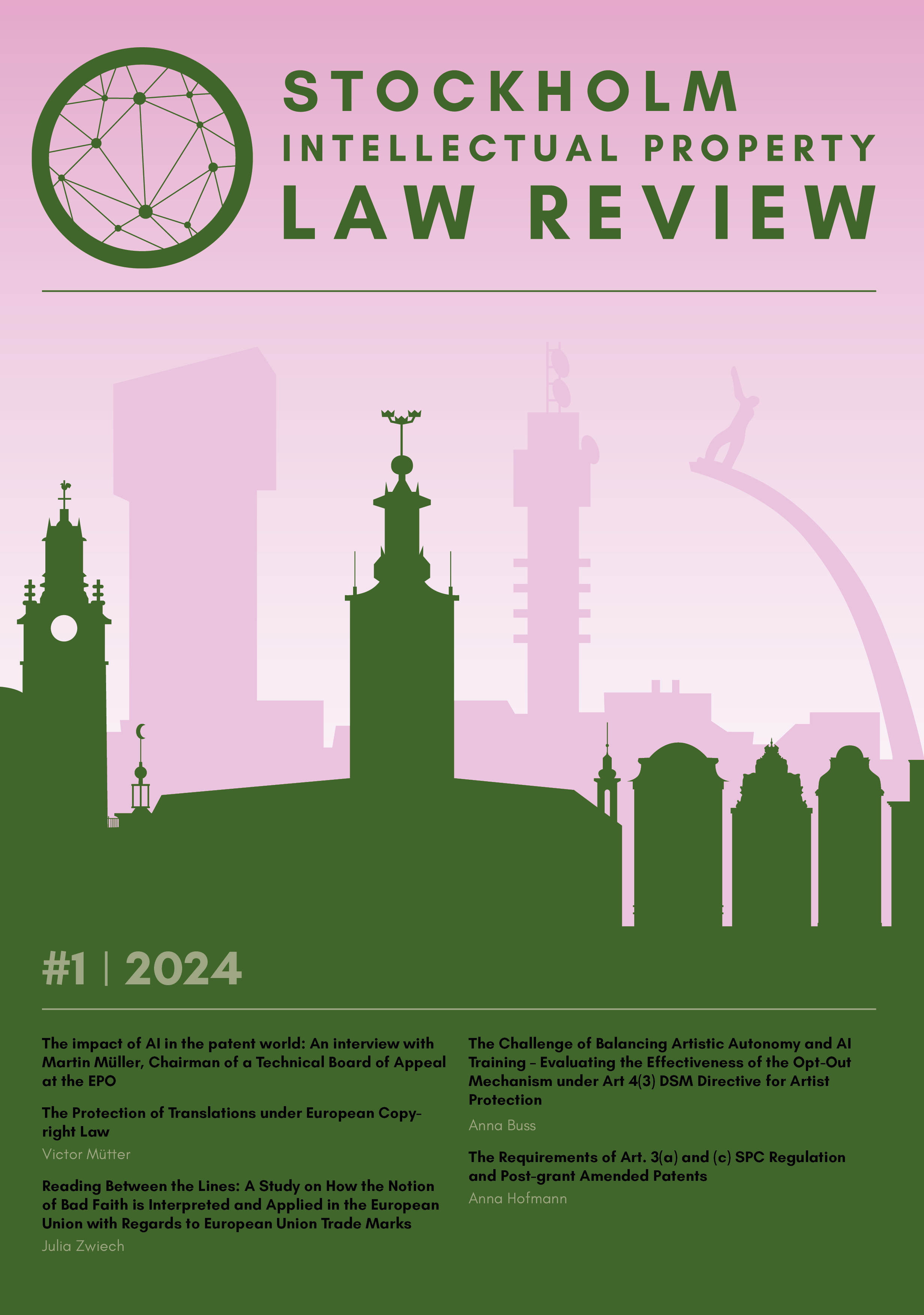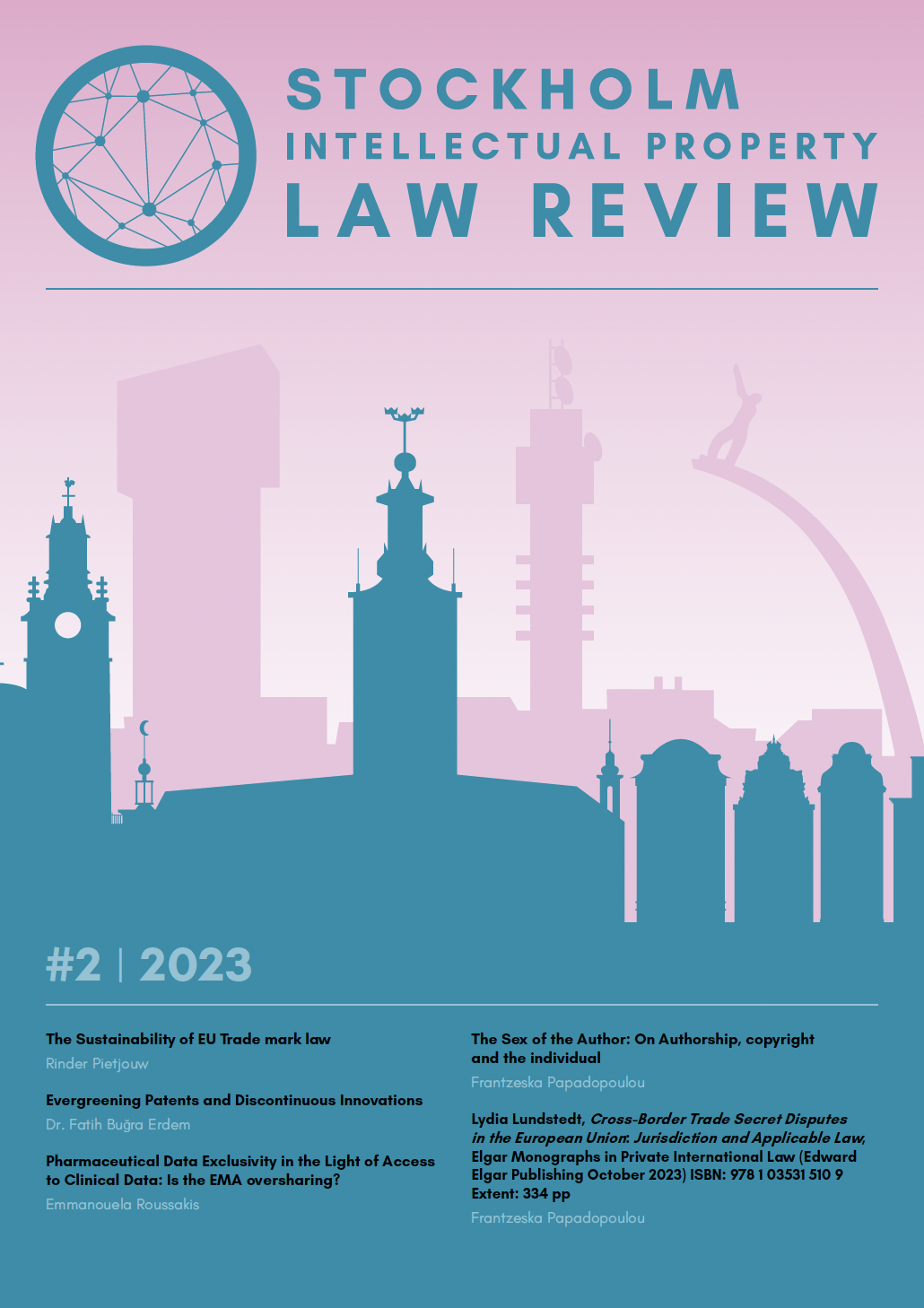
Stockholm Intellectual Property Law Review
#1 2024
Editorial
The first issue of the Stockholm IP Law Review for 2024 arrives amidst significant developments affecting intellectual property rights at both the EU and international levels. One notable advancement is the implementation of the AI Act, which takes effect on August 1, 2024. Proposed by the Commission in April 2021 and ratified by the European Parliament and the Council in December 2023, the AI Act aims to address potential risks posed to citizens’ health, safety, and fundamental rights. It sets forth clear expectations and obligations for developers and users of AI, while also aiming to alleviate the administrative and financial burdens on businesses. The AI Act establishes a cohesive framework across all EU member states, utilizing a proactive definition of AI and a risk-based methodology. While the main text of the law does not touch specifically upon copyright issues, it does repeatedly make specific mention to the topic in the text’s recitals (from 105 to 109) including:
• Recital 105 of the AI Act which reminds of the relevance of the data mining exceptions to copyright introduced by the Directive (EU) 2019/790.
• Recital 107 which stipulates that providers of AI generative models will be required to provide a detailed summary of the content used for the training, in a comprehensive way that will allow copyright or parties with legitimate interests to exercise and enforce their rights under EU law.
In another milestone, WIPO member states have ratified a pioneering Treaty focused on intellectual property (IP), genetic resources, and associated traditional knowledge, marking a historic achievement that culminated decades of negotiations. This Treaty stands as the first to explore the relationship between IP, genetic resources, and traditional knowledge, and it notably includes provisions aimed directly at protecting Indigenous Peoples and local communities.
Once 15 countries have ratified the Treaty, it will introduce a new international law requirement mandating patent applicants to disclose if their inventions are based on genetic resources or traditional knowledge. A signing ceremony is set to take place later today. Negotiations on this Treaty began in WIPO in 2001, following a proposal from Colombia in 1999 that emphasized the participation of Indigenous communities. Simultaneously, the legislative process continues regarding the Commission’s proposal unveiled on April 23, 2024, which seeks to amend and replace existing pharmaceutical legislation (Regulation 726/2004 and Directive 2001/83/EC) as well as legislation concerning medications for children and rare diseases (Regulation 1901/2006 and Regulation 141/2000/EC). The proposal aims to achieve several key objectives:
• Ensure all EU patients receive timely and fair access to safe, effective, and affordable medications.
• Strengthen the security of supply, ensuring medicines are accessible to all patients within the EU.
• Maintain a conducive and innovative climate for pharmaceutical research, development, and production within Europe.
• Promote the environmental sustainability of medicines.
• Tackle antimicrobial resistance (AMR) and pharmaceutical contamination in the environment by adopting a One Health perspective.
Together, these three concurrent developments are pivotal to the ongoing transformation of the contemporary intellectual property rights system while also significantly impacting societal goals, including the ethical use of AI, equitable access to medicines, and acknowledgment of Indigenous communities’ contributions to technological progress. This issue of the Stockholm IP Law Review is representative of the exciting developments in the field of IP.
It is an honor to be able to publish the SIPLR interview with Dr. Martin Müller, the chairman of Technical Board of Appeal 3.5.06, one of the boards dealing with computing technology and artificial intelligence, and Member of the Enlarged Board of Appeal. In this very engaging
interview Dr Müller contributes with valuable input on AI’s impact in the patent world, as well as a career in the patent system. Victor Mütter’s article “The Protection of Translations under European Copyright Law”, explores how the general requirements for copyright protection developed by the Court of Justice of the European Union apply to translations. This is an interesting and unexplored subject. In her article, “Reading between the lines: a glance on how the notion of bad faith is interpreted and applied in the European Union with regards to EU trade marks”, Julia Zwiech analyzes the currently applied subjective/ objective approach towards the finding of ‘bad faith’ and puts forward a suggestion that could lead to an increased clarity and objectivity with this regard.
Anna Buss has in her article, “The Challenge of Balancing Artistic Autonomy and AI Training – Evaluating the Effectiveness of the Opt-Out Mechanism under Art 4(3) DSM Directive for Artist Protection“, engaged in the debate concerning Article 4 of the DSM Directive and its
practical use as a commercial exception for text and data mining. In her article with the title, “The Requirements of Art. 3(a) and (c) SPC Regulation and Post-grant Amended Patents”, Anna Hofmann investigates how procedural and substantive requirements for a patent amendment influence
the interpretation and application of articles 3(a) and 3(c) of the SPC Regulation.
We hope you enjoy reading this issue!
Frantzeska Papadopoulou Skarp,
Chair of the Board SIPLR
Content Editor in chief

Stockholm Intellectual Property Law Review
#2 2023
Editorial
The second half of 2023 was marked by a string of landmark events for – not only – the IP world. With the Age of Artificial Intelligence (AI) in full bloom, several endeavours in the legal world have sought to illuminate the legal issues that have arisen in its wake. In April 2021, the European Commission introduced a regulatory framework for AI – the AI Act. Subsequently, following the proposal and the EU Council’s adoption of proposals in December 2022, the European Parliament released its adopted negotiating position and amendments in June 2023. After a ‘marathon’ of negotiations, a provisional agreement on the AI Act was forged on December 9th 2023. With the AI Act Europe establishes the groundwork for what was to become the first international agreement on the regulation of AI. Albeit IP does not lie at its very core, the AI Act has nonetheless highlighted Europe’s stance on the role of copyright for next generation technologies. That is to say that the AI Act aspires to deal with a situation brought by AI that rightsholders have been preoccupied with – i.e. use of their works for AI training purposes. Increased transparency has understandably been a devout desire of rightsholders, which the AI Act seems willing to fulfil. The Act proposes transparency requirements for generalpurpose AI systems, including technical documentation, compliance with EU copyright law, and disclosure of summaries of the data used for training models. While this requirement aims to reduce unauthorized use of copyrighted material, concerns still linger regarding its effectiveness in preventing infringement, especially since AI developers are not required to provide exhaustive lists of the training data they have used. Furthermore, AI developers argue that implementing these requirements will be complex and could hinder Europe’s AI driven growth, thereby possibly affecting its competitiveness in the ‘tech’ field.
Moving to another important AI-related development in the IP field, on the 20th of December 2023 the UK Supreme Court ruled in the Thaler v. Comptroller case ([2023] UKSC 49). Dr. Stephen Thaler had filed two patent applications for the Comptroller designating the AI system DABUS as inventor. The UK Supreme Court ruled that the current UK patent legislation did not allow the designation of AI as the inventor, emphasising that the 1977 Patents Act stipulates that only a ‘natural person’ is eligible to be recognized as an inventor. Furthermore, the Court held that Dr. Thaler was not entitled to obtain a patent for any invention developed by DABUS based on his ownership of the AI system. The outcome of the case is hardly surprising and echoes the outcome of similar unsuccessful attempts by Dr. Thaler to have DABUS recognized as an inventor, also before the European Patent Office (EPO) and the United States Patent and Trademark Office (USPTO). While AI raises many interesting questions within the field of patent law, the UK Supreme Court ruling confirms that AI inventorship is still largely non-negotiable in most jurisdictions. Despite the AI-intense developments the last months of 2023 were preoccupied with, this issue is not limited to that. You may find yourself intrigued by articles from different areas of IP – spanning copyright, trade mark law, patent law, as well as relevant matters such as data exclusivity. Rinder Pietjouw explores the relationship between EU trade mark law and sustainability with a focus on the potential trade mark law holds for the achievement of the EU sustainability goals, as a result of trade marks’ capacity to communicate and thus achieve transparency. Emmanouela Roussakis’ article deals with EU pharmaceutical legislation or, more concretely, regulatory data exclusivity and the definition of commercially confidential information, considering the balance between commercial interests and transparency in the context of clinical trial data. Dr. Fatih Buğra Erdem’s article addresses evergreening practices in patent law and their consequences, including their impact on competition. Last but not least, the article by the founder and content editor of the Stockholm IP Law Review, Professor Frantzeska Papadopoulou, deals with the concept of authorship both in the film industry and in copyright law with a focus on female authors, showing how women have been visible during the debates on authorship and copyright law in the Swedish film industry from early on.
This issue marks the inaugural occasion for the student editors of the Stockholm Intellectual Property Law Review to introduce a SIPLR issue by a student editorial, an endeavor we undertake with great enthusiasm. We take this moment to reflect on the privilege of serving as editors in a student-led journal. Through the plethora of enlightening contributions, we have the opportunity to delve into the forefront of debates within the IP field and actively participate in their dissemination. This invaluable experience not only enriches our understanding of IP but also serves as a wellspring of inspiration for our academic pursuits. We extend our heartfelt gratitude to all contributors and express a special appreciation to Professor Frantzeska Papadopoulou, Founder of the Stockholm IP Law Review for allowing us to partake in this exciting project and guiding us throughout this journey.
We hope you enjoy reading the latest issue of the Stockholm IP Law Review.
Student editor-in-chief and the editorial team
